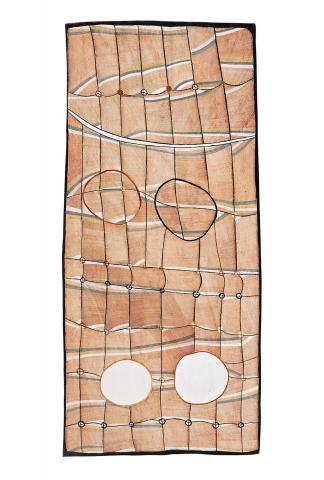MILMILNGKAN, 2008
JOHN MAWURNDJUL
natural earth pigments on eucalyptus bark
178.0 x 82.0 cm
Maningrida Arts and Culture, Maningrida, Northern Territory (label attached verso)
Chapman Gallery, Canberra
Private collection, Melbourne
This painting is accompanied by a certificate of authenticity from Maningrida Arts and Culture, Northern Territory.
Milmilngkan is a billabong approximately 60 kilometres south of Maningrida in central Arnhem Land, a place where John Mawurndjul has a seasonal camp and house not far from the edge of a small creek. It is an important site in Kuninjku cosmology, for as Mawurndjul reveals in the accompanying certificate, beneath the water of Milmilngkan lies the power of Ngalyod the Rainbow serpent, a familiar subject of contemporary Kuninjku bark paintings. Ngalyod is associated with the creation of all sacred sites (djang) in Kuninjku clan lands and ancestral stories relate how creator or ancestral beings travelling across this country had angered Ngalyod who then swallowed them and returned to the earth to create this site. Today, Ngalyod protects all sacred sites and its power is present in each one. Having both powers of creation and destruction Ngalyod is most strongly associated with rain, monsoon seasons and rainbows. Being both a destroyer and a giver of life, Ngalyod's power controls the fertility of the country and the seasons.
With an artistic career spanning over thirty years John Mawurndjul is one of Australia's most successful and ground breaking contemporary artists. Guided by his father Anchor Kulunba, elder brother Jimmy Njiminjuma and his uncle Peter Marralwanga, he had a very traditional upbringing resulting in an extensive knowledge of ritual ceremony and strong interest in his cultural heritage. Mawurndjul’s early painting lessons were decorating bodies for dance and initiation ceremonies. Recalling his early involvement in ceremonial preparations he said, ‘I saw my father doing the rarrk (cross hatching) for the Mardayin ceremony and tried to do it myself with my back all doubled over, I ended up being better than any of them at it. They gave me a job in the Mardayin ceremony to paint some rarrk. When they all saw me doing it they said ‘wow’, he’s got the hang of it. ‘You’ve left us behind my son’, they said to me’.1
Originally painting figures and creatures in Kuningku mythology, he has over the years developed a more metaphysical representation of specific sites, events and landscape with fine lineal clan designs spreading across the surface of his paintings. Mawurndjul is constantly striving for new ways to interpret his country through innovative use of rarrk and clan designs. It is the representation of important locations and mapping within his clan sites and djang that is most important to him. His paintings are now composed of vast expanses of rarrk with shifting patterns of grids rendered in fine interlocking lines. ‘I never stop thinking about my rarrk, month after month, I keep putting my ideas into my barks. I’ll never stop painting.’2
1. rarrk: John Mawurndjul, Journey Through Time in Northern Australia, Museum Tinguely, Basel, 2005, p. 43
2. ibid. p. 28 in an interview with Apolline Kohen
CRISPIN GUTTERIDGE
